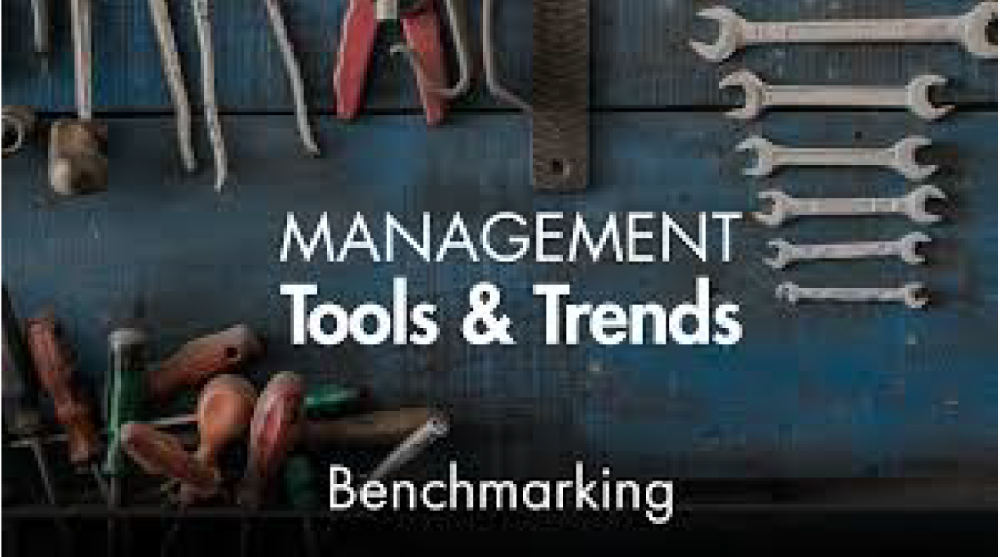Researched and Presented by
Walter J. McDonald, President The McDonald Group, Inc.
walt@mcdonaldgroupinc.com • www.mcdonaldgroupinc.com
The customized development program designed for machinery OEM customer contact managers and senior distributor/dealer executives and managers. This is the OEM Curriculum Track. A Certificate in Machinery Dealer Development will be awarded upon successful completion of all course and study requirements. Mr. McDonald will work personally with each participant on assignments, discussion sessions and study projects in each module. Video conference sessions will enable each participant to receive private coaching on coursework. Regional Managers are organized into Study Teams for Assignments and Zoom Reviews.
Regional Teams Work Together to:
- Evaluate and Strengthen Dealer Market Position
- Examine Best Practices in Sales and Operations Management at Both the OEM and Dealer Levels.
- Improve Dealer Market Penetration
- Build Dealer Development Problem-Solving Skills
- Strengthen Relationships with Dealer Principals and Managers
Workshop Highlights…
- Examine the Roles and Responsibilities of a highly-effective Dealer Development Manager.
- Work in a small group to Audit each Dealer Sales, Rental and Aftermarket Operations against our high-performance dealer checklist.
- Identify and discuss the critical success factors for each Dealer that contribute most to improve Dealer Profitability, Cash Flow, OEM Market Share and Customer Service & Retention.
- Special section on aftermarket operations and aftersales marketing based on world-class dealer best practices and performance metrics.
- Build a performance improvement plan for each regional OEM dealer.
The very best industry-specific workshop custom-designed for OEM Level Regional Sales Managers (RSM) and Inside Support Personnel and Dealer Executives. Assess dealer development problems, discuss issues, complete dealer performance improvement planning projects. Examine and discuss the critical role and responsibilities of Managers responsible for dealer development, how to build better dealer relationships and how to motivate the dealer teams to respond more favorably to your leadership and encouragement.
2025-26 Curriculum-OEM Management Track Click for Course Details
The special modules for OEM managers are highlighted below. We currently have OEM managers all over the world participating in this popular program. Work at your own pace. You will receive private coaching from Walter McDonald on each assignment.
1. Importance of Quants
The role of quantitative assessments in building dealer profitability, market share and customer retention. Review critical revenue center management tools and operations performance metrics that enable your dealers to best control their businesses.
2. Eight Crucial Dealer Development Tools
This first of three modules on how to build a better working relationship with your dealers. This module includes an assessment of the ① Strategic Dealer Profile, ②Market Development Profile, ③ Dealer Sales Performance Metrics, ④ Dealer Product Support Performance Profile, ⑤ Dealer Focus and Line Specialization Assessment, ⑥ Dealer Development Portfolio, ⑦ Benchmarking-The Quantitative Dealer Performance Assessment, and, ⑧ McDonald’s Dealer Track for Master’s Program
3. Customer Service and Retention
How to build value delivery in every dealer customer interaction. Examine best practices and premiere dealer metrics. Identify performance standards and tools essential to manage customer expectations and maintain high levels of customer retention. Investigate how to best monitor dealer performance, listen to the voice of the customer and how to develop the employee customer retention team.
4. Parts Operations
We begin this first of four modules on Dealer Revenue Center Management with a discussion on Performance Improvement Management Tools. Examine best practices and premier dealer metrics. Examine why Off-Shelf Parts Fill Rate to Service is the single most important performance measurement in a machinery dealership. Discuss how obsolescence impacts parts fill rate and inventory turns. Review best approaches to improve Parts Fill Rate, Parts Warehouse Management, Parts Inventory Management, Parts Business Management, and Parts Employee Development.
5. Service Operations
Examine dealer best practices and premier dealer metrics. Project current real cash loss of low current field service and shop technician productivity. Identify drivers of individual technician productivity and shop recovery rate. Discuss the benefits of tracking technician efficiency and how to structure standard times in every shop environment. Review best approaches to Service Operation and Work Order Management, Service Supervisory Management, Service Labor Productivity Management, Service Business Management, and Service Employee Development. A special section on “How to Sell Planned Maintenance”has been added for 2023, beginning with an examination of the techniques and benefits of thorough inspections
6. Product Support as a Competitive Weapon
The big differentiator today in machinery distribution is product support. How to determine a competitor’s aftermarket vulnerability. How to leverage this advantage. Discuss how to significantly increase the value delivery in your aftermarket product support business. You will examine how to optimize aftermarket market penetration to achieve high levels of Absorption Rate. How to project market size and share for your primary product line.Analytical tools that clearly identify high potential accounts for incremental business.Promotional tools and techniques that yield the best results. And finally, you will evaluate your website to determine if it is doing its job in representing your dealership.
7. Building an Optimum Manufacturer – Dealer Partnership
Examine the critical nature of dealer relationships and the bias, fears and concerns of most dealer principals. Examine the structural, economic and statistical differences between dealers and large manufacturers. Discuss how to build trust and move to consultative selling. Learn the three dealer development roles in which you must gain expertise. See how to move up the relationship hierarchy with the dealer principal, gaining their trust and confidence. Examine how the dealer development profile serves as the heart of consultative selling and your successful dealer development efforts.
8. Rentals and Used Machinery Sales and Operations
Examine dealer best practices and premiere dealer metrics. How to Conduct a Rental Market Assessment, utilize a Rental Rate Calculator, establish Rental Revenue and Profit Controls, structure proper Rental Business Policy, and potential for Long Term Rentals. Create a Used Machinery Market Development Strategy, structure proper Used Machinery Inventory Controls and study the Eight AXIOMS for Used Machinery Success.
9. New Machinery Sales and Sales Management
Examine dealer best practices and premier dealer metrics. Create a comprehensive Market Development Strategy. Build an effective Key Account Development Strategy. See how team selling with Product Support gives you a strong competitive edge. Discuss best approaches to Machinery Sales Rep Quick-start and Development, Sales Supervision, and Sales Management. A special section on Key Account Management discusses how to assess customer roles, rating buyer support and degree of influence, and get up to higher levels in the account. See how to best utilize the Key Account Management Profile. Review how to avoid the 10 biggest mistakes in Key Account Management. Learn See how to assess the prospect’s fear level. And, examine the Key Account Management checklist.Two new Resources include “Industrial & Ag Equipment Sales Prospecting and Skills Development Kit” and “Sales Operations Assessment for the Newly Appointed Multi-Branch Machinery Sales Manager.”
10. Building an Optimum Manufacturer — Dealer Partnership—Part 2.
This exercise begins with a comprehensive Bench marking effort comparing current dealer performance(s) to those high-profit dealers. You will then assess Dealer Strengths vs.Market Attractiveness and build a Dealer Development Portfolio. You will utilize the Dealer Evaluator to objectively define where your regional dealers stand today on a two-dimensional matrix defining market attractiveness and strength of dealer position. You will assess which of your dealers are Stars, Question Marks or Fallen Stars. And, you will structure and discuss preliminary dealer development action plans for your market area.
11. Final Action Plans, Tools and Strategies for Successful Implementation
This is a critical section of the program and a substantial effort should be made to create a comprehensive, practical dealer development plan for each of your dealer accounts. What are the three to five management actions that must be taken in each area to improve overall dealer performance. Project financial impact of proposed Action Plans. Examine how to ensure successful implementation. Many great plans never get executed because of the rush of day-to-day business. Utilizing these implementation tools will help ensure your success. Included is a discussion on how to best work with Dealer Principals, senior executives and their top management teams.
Required Texts: The 11-volume “Master’s Program in Dealer Management” by Walter J.McDonald. Many of the exercises, readings and program activities are in these essential textbooks. You must have a set to participate in this training activity. (See next pages.)
OEM Tuition
Executive Program in Dealer Development including Textbooks
Individual student Tuition for this 11-module personalized, management training program includes our new text, DEALER DEVELOPMENT-OEM Regional Manager’s Guide in the 11-volume Master’s Program in Dealer Management book set by Walter McDonald, plus “The 4 Disciplines of Execution” by Sean Covery. For tuition details please contact walt@mcdonaldgroupinc.com.
The Master’s Program in Dealer Management
OEM Student Book Set
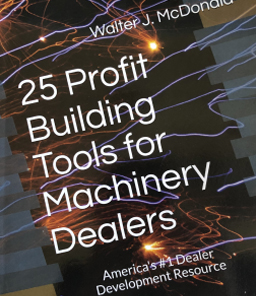
25 Profit Building Tools for Machinery Dealers
Practical, Cost-Effective IT Solutions. Dealer Management Tools to:
Increase Gross Profit Margin
Decrease Cost of Sales
Decrease Expenses
Increase More Profitable Sales Volume
Special Report:
Return on Net Assets

Achieving Excellence in Dealer/Distributor Performance with Reader’s Guide
Revenue Center Performance Benchmarks
Aftermarket Sales and Operations
New Machinery Sales Management
Ultimate Financial Survival
Special Reports:
OEM Agreements
Product Support Success Story

Strategies, Tactics, Operations for Achieving Dealer Excellence with Reader’s Guide
Six Strategic Questions Best Practices Audits: Customer Retention, Parts, Service, Rentals, Used and New Machinery.
HOW TO:
Handle Angry Customers
Conduct Successful Aftermarket Marketing
Develop a High Performance Team
Manage Key Accounts
Structure Accelerated Start-Up for New Sales Reps
Best Access Trade Associations
Build a Big Hairy Audacious Profit Model
Special Reports:
Becoming a More Effective Manager
Increase Service Labor Productivity
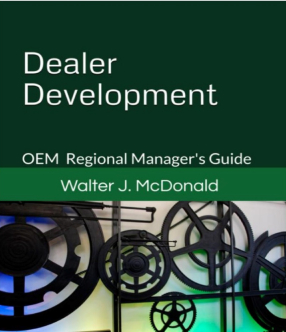
Dealer Development -OEM Regional Manager’s Guide
Three OEM Dealer Development Case Histories: 1970’s J.I. Case, 1980’s Bobcat, 1990’s –MCFA
Building an Optimum Manufacturer Dealer Partnership
Comprehensive Dealer Recruitment Program
The OEM Perspective—Optimizing Field Team Results
The Dealer Perspective—What is needed and expected
The “Never Do’s”
The Eight Essential Dealer Development Tools
Data Analytics for Sales and Marketing Strategy
Returns on Digital Investments
How to Avoid Death by 10,000 Cuts, or, to Improve Cash Flow
High Profit Performance Metrics and World Class
Best Practices by Revenue Center: Parts, Service, Rentals, Used Machinery, New Machinery and, Customer Retention
How Dealers Evaluate their Manufacturers
Best Practices in OEM Dealer Development
Powerful New Market Share Development Strategy
How to Begin Product Support Development Efforts
How to Begin Machinery Sales Development Efforts
How Dealers Can Avoid Problems with OEM Sales and Service Agreements
“The professional guidance offered here in Dealer Development: OEM Regional Manager’s Guide is most remarkable and the best in the industry.”
Andrew Li, Vice President at Toyota Industrial Equipment, Shanghai
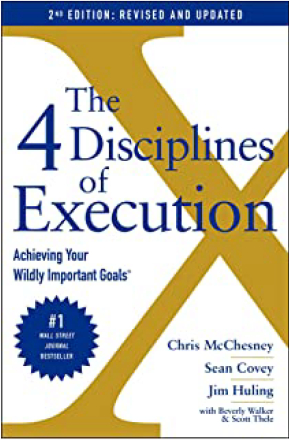
The 4 Disciplines of Execution
by McChesney and Covey.
Used in Major Action Plan Development Project Assignment

Dealer Problem-Solving Handbook for Master’s Program in Dealer Management
The Problem-Solving Process 189 Issues, Problems and Possible Solutions:
Dealer Principal/Ownership
Parts Operations
Service Operations
Rental Operations
Used Equipment Operations
New Equipment Operations
Special Reports:
Organizational Development
Vendor Relationships
Banking Relationships
Controlling Obsolete Inventory
Dealer Project Planner Worksheets
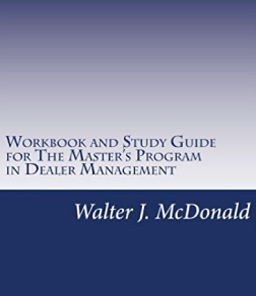
Workbook and Study Guide for Master’s Program in Dealer Management
Road Map for Master Improvement Plan
“600” World Class Best Practices (pp. 32-33)
Worksheets for Dealer Principals/Executives
Worksheets for Service and Parts Managers
Worksheets for Machinery Sales, Rental Managers
Pulling It All Together for All Dealer Managers

Comprehensive Self-Study Curriculum for Master’s Program in Dealer Management
Full Curriculum for Master’s Program—Complete Assessment of Performance Benchmarks. World-Class Best Practices in Each Revenue Center
Professional Growth and Development Plan
New Insights into Information Technology
13 Chapters on Product Support Management
20 Chapters on Marketing, Sales, Sales Management

Service Mangement – Machinery Dealer Manger’s Handbook
Service Business Management
Service Operations Management
Successful Technician Recruiting, Onboarding
Leadership and Supervisory Management
Aftermarket Marketing and Sales
Customer Service and Retention
Executive Survey on What’s Working
World Class Service Management Best Practices
Dealer Development Training Resources
12 Essential Strategic Investments
Action Plans for Department Development
Great book! Wish I had it 30 years ago.
Bill Piles, General Product Support Manager at Multi-State Komatsu and John Deere CE Dealers
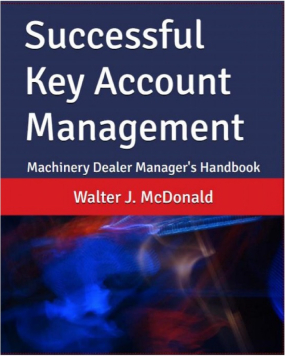
Successful Key Account Management
Key Account Best Practices-Assessment
Assembling the Key Account Team
Gathering Relevant, Important Facts about the Key Account
Identify and Define the Roles of each Key Purchase Influencer
Clarify Influencer Preferences and Fears – Understanding Buying Decisions and the Decision-Making Process
Determine How the Account Views the Dealership on the Customer Relationship Hierarchy
How Customers Evaluate a Potential Machinery Dealer
Establish Product Support as a Competitive Weapon
Assess Realistic Revenue Potential Including Product Support
The Easiest Way to Hit Your Revenue Goals
Developing Necessary Dealer Selling Skills
Contact Strategy to Successfully Service All Accounts to Optimize Market Share- A/B Account Growth Strategy
Participation Rate and Market Share
How to Dodge the Biggest Mistakes In Key Account Management
How to Avoid the Biggest Vulnerabilities in Key Account Management
Customer Acquisition via Tender/Bid
Highly Recommended Supplemental Student Reference Materials
Available on Amazon.com:

Collaborative Selling
By Tony Allessandra and Rick Barrera
Used as supplemental readings in Sales and Sales Management Assignments
Helpful Insights into Key Account Management
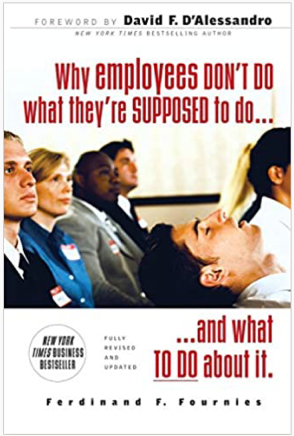
Why Employees Don’t Do What They’re Supposed to Do
By Ferdinand F. Fournies
Resource for Personal Self-Development Assignment
Shop-proven approaches to employee performance improvement.
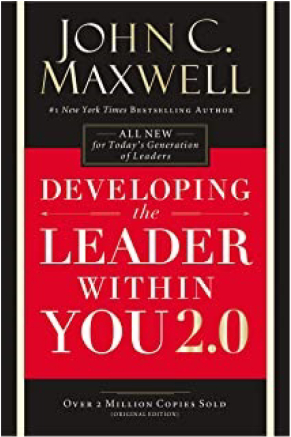
Developing the Leader Within You 2.0
By John C. Maxwell
Resource for Personal Self-Development
Indispensable guidelines for strengthening supervisory effectiveness.
Biographical Data Sheet
WALTER J. McDONALD, CMC
Walter McDonald is founder of The McDonald Group, Inc., a private consulting firm focusing on industrial marketing and business strategies, executive education and development. For the past 45 years, Walter has been a highly respected construction equipment, farm power, material handling, forestry, turf equipment and heavy-duty truck industry seminar leader. In addition, he has worked on numerous business consulting assignments for manufacturers and dealers helping improve dealer operations, market share and profitability.

